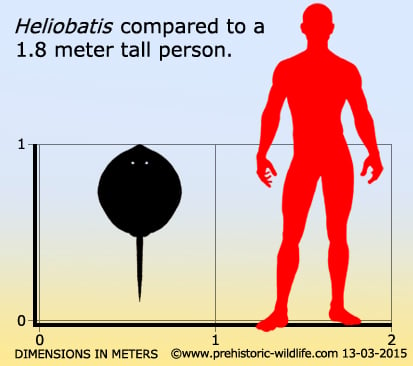In Depth
Heliobatis is a prehistoric ray that was discovered in the Green River Formation, a deposit well known for its numerous fossils of fish including Knightia and Diplomystus. Specimens of Heliobatis range between eight and ninety centimetres, although the average is between thirty and forty centimetres. Half of the total body length of Heliobatis is taken up by the tail. The tail of Heliobatis has up to three modified denticles that form barbs, but no one can say for certain how toxic these barbs could have been.
Heliobatis seems to have preferred crustaceans such as crayfish and shrimps as indicated by the abundance of Heliobatis fossils in association with their prey items. The teeth in the mouth of Heliobatis are small and triangular, making the teeth better suited for crunching the exoskeletons of prey.
Like many American prehistoric animals, Heliobatis was discovered during the bone wars, a rivalry between the palaeontologists Othniel Charles Marsh and Edward Drinker Cope. Marsh named the first albeit incomplete specimen Heliobatis. Two years later Cope came across another specimen and named it Xiphotrygon, but because Marsh named his first, Xiphoctrygon became a synonym to Heliobatis. Heliobatis itself means ‘sun ray’, but it should be remembered that the ray part is in reference to the type of fish that Heliobatis is, and is not in reference to a ‘ray of sunshine’.
Further Reading
– Paleontology of the Green River Formation, with a review of the fish fauna. – Bulletin of the Wyoming State Geological Survey. – Lance Grande – 1984. – Freshwater stingrays of the Green River Formation of Wyoming (early Eocene), with the description of a new genus and species and an analysis of its phylogenetic relationships (Chondrichthyes, Myliobatiformes). – Bulletin of the American Museum of Natural History 284: 1–136. – M. R. Carvalho, J. G. Maisey & L. Grande – 2004.










